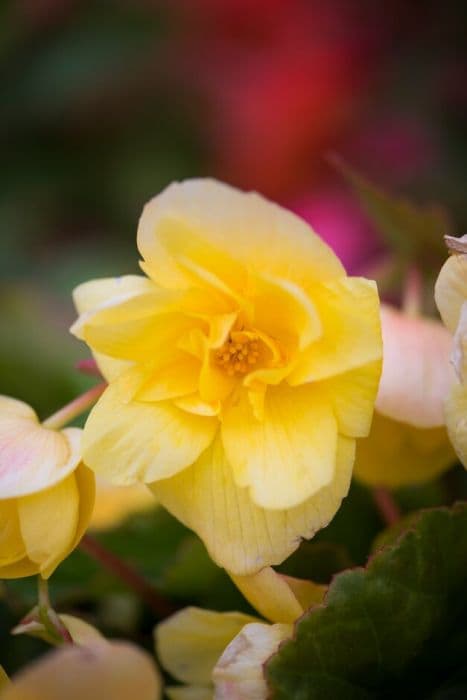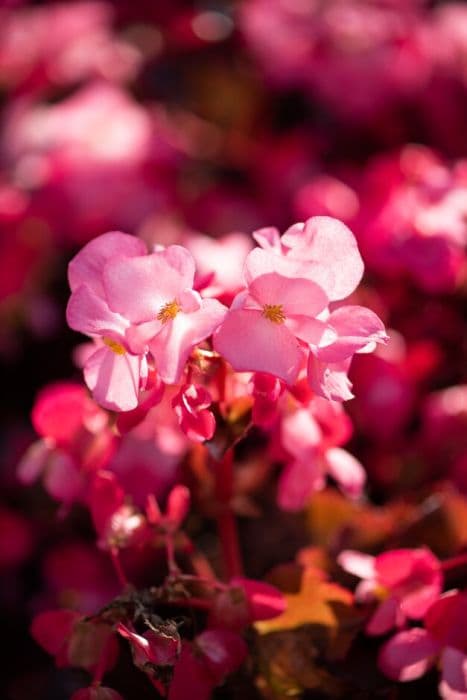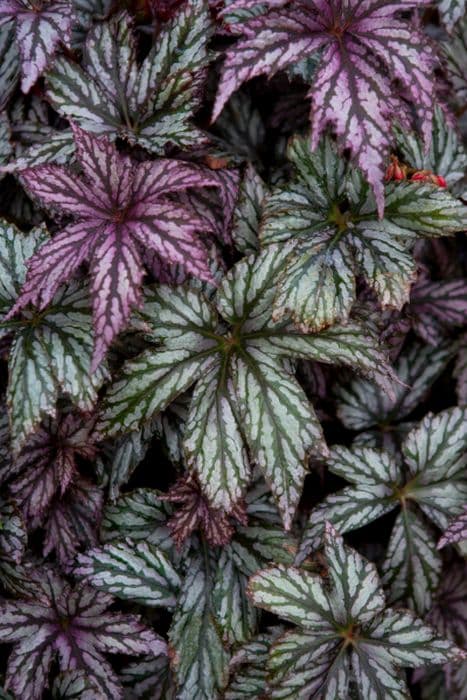Mapleleaf Begonia Begonia dregei (T)

ABOUT
Begonia dregei, commonly known as the Maple-leaf Begonia due to its foliage shape, is a visually captivating plant that boasts a distinctive appearance. Its leaves are a standout feature, closely resembling the lobed leaves of a maple tree. The foliage is typically rich green, and the texture can range from smooth to slightly hairy, providing a lush, velvety look. The underside of the leaves often displays a contrasting reddish hue, which becomes especially prominent along the veins. The leaves emerge from a central point, creating a symmetrical, radial pattern that enhances the plant's ornamental appeal. Flowers produced by the Maple-leaf Begonia add to its decorative charm. They form in clusters and may vary in color, usually presenting shades of light pink, white, or pale yellow. These flowers are modest in size and have symmetrical petals that contribute to the plant's overall aesthetic. The blossoms arise on delicate stems that hover gracefully among the foliage. The Maple-leaf Begonia's overall growth habit is one of gentle spreading or trailing, depending on its growing conditions and support. This makes it particularly suitable for hanging baskets or as an elegant understory plant in mixed plantings where its unique leaf shape can complement other flora. Its form provides a soft, green cascade that can soften the edges of containers or garden beds.
About this plant
 Names
NamesFamily
Begoniaceae
Synonyms
Small Dewflower, Maple-Leaf Begonia, Dwarf Begonia
Common names
Begonia dregei var. Partita, Begonia montana var. Dregei, Begonia dregei var. Gronovii
 Toxicity
ToxicityTo humans
The plant commonly known as the Forest Begonia is not highly toxic to humans, but it does contain oxalate crystals. If any part of the plant is ingested, it can cause irritation in the mouth, throat, and may lead to gastrointestinal discomfort such as nausea, vomiting, and diarrhea. It's advisable to avoid consuming this plant.
To pets
Similar to its effects on humans, the Forest Begonia is mildly toxic to pets due to the presence of oxalate crystals. If ingested by animals such as dogs and cats, it could cause oral irritation, drooling, vomiting, and difficulty swallowing. Pet owners should prevent their animals from eating this plant to avoid these symptoms.
 Characteristics
CharacteristicsLife cycle
Perennials
Foliage type
Evergreen
Color of leaves
Green
Flower color
Pink
Height
1ft 2in (35cm)
Spread
1ft 2in (35cm)
Plant type
Herb
Hardiness zones
10
Native area
South Africa
Benefits
 General Benefits
General Benefits- Aesthetic Appeal: Begonia dregei, commonly known as the Maple Leaf Begonia, is admired for its ornamental foliage and delicate flowers, adding a splash of beauty to gardens and indoor spaces.
- Versatility in Landscaping: It can be used in various garden settings, including borders, ground covers, and container gardens, due to its compact growth habit.
- Shade Tolerance: Maple Leaf Begonia thrives in shaded areas where other plants may struggle, making it a valuable addition to shaded gardens.
- Easy to Propagate: Its ability to be easily propagated by leaf cuttings or division allows gardeners to multiply their collection or share with others.
- Low Maintenance: It requires minimal care compared to many other plants, with no need for frequent watering or specialized fertilizing, making it ideal for busy plant enthusiasts.
- Drought Resistance: Once established, it can tolerate periods of drought, reducing the need for constant irrigation and conserving water resources.
 Medical Properties
Medical PropertiesThis plant is not used for medical purposes.
 Air-purifying Qualities
Air-purifying QualitiesThis plant is not specifically known for air purifying qualities.
 Other Uses
Other Uses- The leaves of Begonia dregei can be used in floral arrangements to provide a tropical look due to their unique texture and color.
- The juices of the stem have been traditionally used as a natural adhesive in small-scale repairs, such as mending paper or light fabric.
- In some cultures, crushed Begonia dregei leaves are rubbed onto outdoor wood furniture to impart a subtle fragrance and to deter insects due to the plant's natural compounds.
- This plant's leaves are sometimes used in the art of leaf impression painting, where the texture patterns are transferred to paper or canvas.
- Competitive growers of Begonia dregei may use this plant in horticultural shows, focusing on unique leaf shapes and variegation as a measure of cultivation skill.
- Extracts from the plant are sometimes incorporated into natural dyes for fabrics, offering subtle hues which are prized in artisanal crafts.
- Some enthusiasts practice the art of Begonia dregei leaf carving, creating intricate patterns by carefully removing layers of leaf tissue.
- Crushed leaves have been used to create natural pest repellents for protecting other plants in gardens and greenhouses.
- During humid seasons, potted Begonia dregei can be placed in closets or small rooms to help absorb excess moisture due to their large leaf surface area.
- Leaf cuttings from Begonia dregei can be used to start new plants, for educational purposes in schools or workshops teaching propagation techniques.
Interesting Facts
 Feng Shui
Feng ShuiThe Begonia is not used in Feng Shui practice.
 Zodiac Sign Compitability
Zodiac Sign CompitabilityThe Begonia is not used in astrology practice.
 Plant Symbolism
Plant Symbolism- Caution: Begonias, including the Begonia dregei, are often associated with a message of caution. It is believed that because begonias have delicate flowers and stems that can be easily harmed, they remind one to proceed carefully in new situations.
- Individuality: This plant's unique foliage and growth habit symbolize individuality and the importance of standing out from the crowd.
- Harmony: The symmetry and balance found in the leaves and flowers of the Begonia dregei can represent harmony and balance in one's life.
 Water
WaterThe Forest Star Begonia should be watered thoroughly once the top inch of soil feels dry to the touch; this may amount to approximately every 7 to 10 days, depending on the environmental conditions. When watering, use lukewarm water and aim to wet the soil evenly without saturating it, generally using about 8-16 ounces of water for a standard pot size. It's crucial to avoid letting the pot stand in water, as this can cause root rot. During the winter months, reduce the frequency of watering since the plant's growth slows down.
 Light
LightThe Forest Star Begonia thrives in bright, indirect light. A spot near an east or west-facing window where it can receive filtered sunlight is ideal. Direct sunlight can scorch its leaves, so it’s crucial to ensure the light is diffused or the plant is set a bit back from the window to avoid intense sun exposure.
 Temperature
TemperatureForest Star Begonia performs best in temperatures between 60 to 75 degrees Fahrenheit. It can tolerate a minimum temperature of about 50 degrees Fahrenheit but should not be exposed to temperatures lower than this as it can cause stress or damage. Avoid placing the plant near drafts, heating, or cooling appliances to maintain a consistent temperature range.
 Pruning
PruningPruning the Forest Star Begonia encourages a bushier growth habit and helps maintain the plant's shape. Prune in the spring before the onset of the new growth period by removing any dead or damaged leaves and trimming back excessively long stems. This can be done every few months or as needed to keep the plant looking tidy.
 Cleaning
CleaningAs needed
 Soil
SoilThe ideal soil mix for Begonia dregei, commonly known as Forest Begonia, should be rich in organic matter, well-draining, and slightly acidic to neutral in pH (around 6.0-7.0). A blend of peat moss, perlite, and pine bark in equal parts is recommended to ensure proper moisture retention and drainage.
 Repotting
RepottingForest Begonia (Begonia dregei) should be repotted every 1-2 years, or whenever it outgrows its pot. The best time to repot is during spring or early summer when the plant is actively growing.
 Humidity & Misting
Humidity & MistingForest Begonia thrives in high humidity conditions, ideally between 60-70%. Constant, but not overwhelming, humidity is beneficial for the plant's health and leaf condition.
 Suitable locations
Suitable locationsIndoor
Use rich, well-draining soil and place in bright, indirect light.
Outdoor
Provide dappled shade, protect from harsh elements, ensure good drainage.
Hardiness zone
10-11 USDA
 Life cycle
Life cycleBegonia dregei, commonly known as the maple-leaf begonia, begins its life cycle as a seed, which germinates in warm, moist soil conditions to produce a small seedling with characteristic asymmetrical leaves. The seedling grows into a juvenile plant, developing a tuberous root system and a rosette of leaves; it prefers shaded environments with indirect sunlight. As the plant matures, it enters the vegetative stage, producing larger leaves and sometimes branching. Upon reaching maturity, the maple-leaf begonia initiates the reproductive phase, characterized by the development of unisexual flowers—separate male and female blooms on the same plant. After pollination, the female flowers produce winged capsules containing seeds, which are then dispersed to start a new cycle. Throughout its life, the maple-leaf begonia requires consistent moisture and humid conditions to thrive, often found in forest undergrowth or as a cultivated houseplant.
 Propogation
PropogationPropogation time
Spring-summer
The Dragon Wing Begonia, known as Begonia dregei, can be effectively propagated through stem cuttings. This popular method, usually carried out in spring or early summer to allow for ample growing time, begins with taking a 3 to 5 inch (approximately 7.5 to 12.5 cm) cutting from a healthy parent plant. The cutting should include at least one node, which is where the leaf joins the stem and new growth will emerge. It is recommended to remove the lower leaves and dip the cut end in rooting hormone powder to encourage root development. The prepared cutting is then placed in a pot with well-draining soil or a mix of peat and perlite, ensuring that at least one node is buried. The cutting should be kept in a warm, brightly lit area without direct sunlight and the soil should be kept consistently moist but not waterlogged. With proper care, roots will develop in a few weeks, after which the new plant can gradually be acclimatized to less humid conditions and eventually treated as a mature plant.



![Begonia [Bonfire]](/_next/image?url=https%3A%2F%2Fplants-admin.emdemapps.com%2Fimages%2Fplants%2F%2Fimages%2F604b6124363f0.png&w=640&q=75)


![Begonia [Devotion]](/_next/image?url=https%3A%2F%2Fplants-admin.emdemapps.com%2Fimages%2Fplants%2F%2Fimages%2F604b58183573b.png&w=640&q=75)


